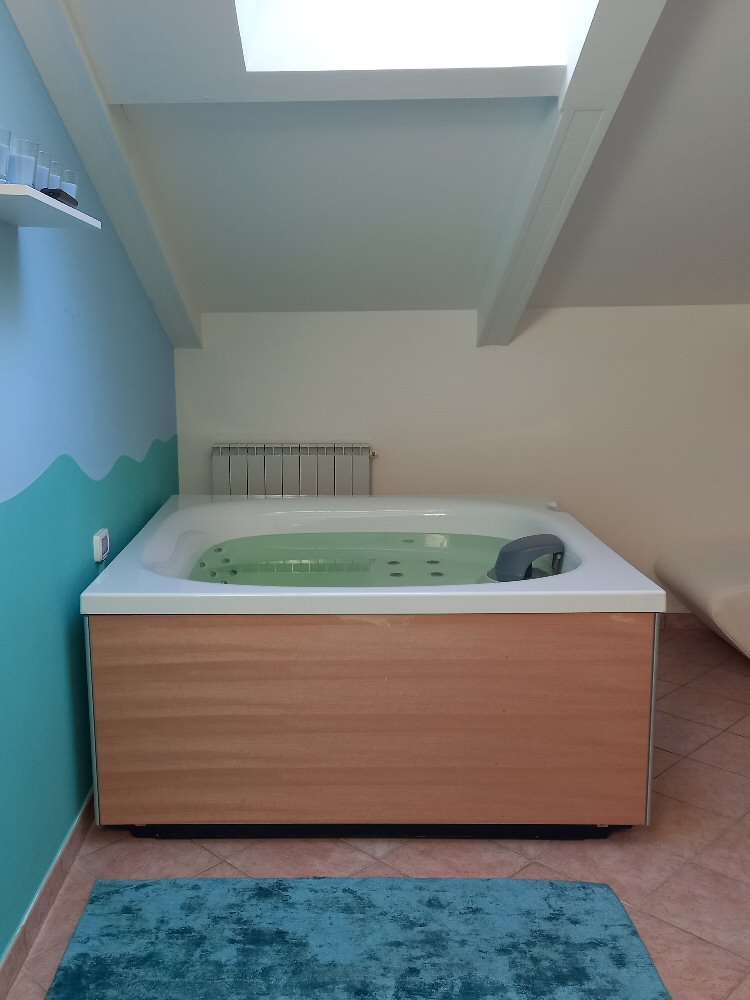
Surroundings
The enchanting landscape of Trasimeno nestled in the hills between Umbria and Tuscany
The district of Lake Trasimeno is ideally located in the center of Italy, between Tuscany and Umbria.
The harmonious coexistence of green rolling hills, typical of the Umbrian countryside, with the charming panorama of the lake, its islands and the small old towns rich in history, art and culture, make this an area of considerable charm that is becoming increasingly popular with both Italian and foreigner tourists.
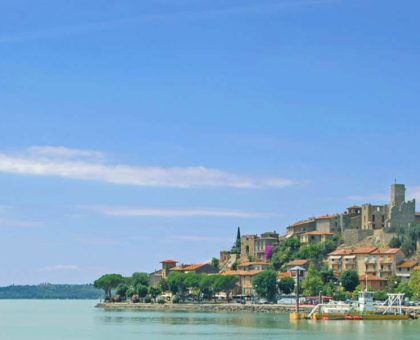
Passignano sul Trasimeno
An ancient fishing village nestled between the blue waters of Lake Trasimeno and the surrounding green hills, Passignano is a veritable gem and a must-see between Umbria and Tuscany.
The Hotel Kursaal is located right in Passignano sul Trasimeno, a few minutes walk from the historic center and in the immediate vicinity of the lake, in a strategic position to allow you to enjoy your holiday to the fullest.

Lake Trasimeno’s villages
The Trasimeno is a unique area, rich in art and culture. Spectacular vistas and enchanting glimpses born of the harmonious intertwining of the green Umbrian hills with the lovely panoramas of the lake and its islands and ancient towns.
Castiglione del Lago, Città della Pieve, the lovely villages of Panicale and Paciano make this an area of considerable charm that is becoming increasingly popular with both Italian and foreigner tourists.

Perugia
Perugia is one of the most beautiful Etruscan cities in Italy. Its warmly coloured stones, its majestic palazzi and its climbs and descents have fascinated poets and artists throughout the centuries. The old town is set on a hill and the other hills, visible in many places along the city streets, surround it. The ancient heart of Perugia is a kaleidoscope of shapes, sizes and colours: brick, travertine, marble, columns, arches, doors, walls that trace its long history and that of the peoples and civilizations that have inhabited it: Etruscan, Roman, the wealth of the Papal States.
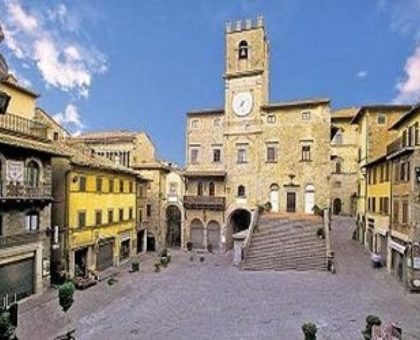
Cortona
Cortona was a free Medieval City with an imposing Medici Fortress and the Palazzi of the old town center, whose walls are covered with the coat of arms of the most important Capitani del Popolo. Many churches are located within the old city walls, sometimes hidden in its characteristic small alleys.
The Monastery, dedicated to Santa Margherita, the matron saint of Cortona, is located on the highest part of the city; from here you can enjoy a vista that includes Valdichiana and part of Lake Trasimeno. Walking through the characteristic ancient streets of Cortona, you can feel the art, culture, gastronomy in the air.
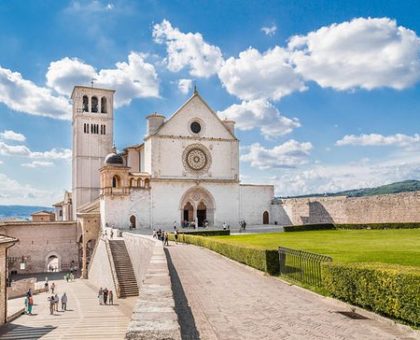
Assisi
The city of pink stone set on the slopes of Mount Subasio is the home of the Umbrian spirituality. The story of its great saints, Francis and Clare combines with the work of the most famous painters of the Middle Ages. You can begin your tour from the highest part of the city, so you can take the easier downhill route.
The Basilica of Saint Clare: Founder of the Poor Clares, St. Clare is buried in the church which also houses the crucifix that spoke to Saint Francis. Piazza del Comune. Austere and elegant public buildings of the Medieval city: the Palazzo dei Priori, Palazzo del Capitano del Popolo and the Torre del Popolo. A remarkable Roman temple known as the Temple of Minerva is set between them.
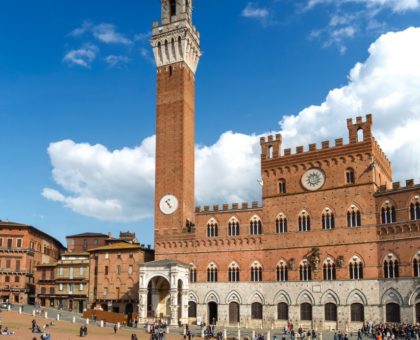
Siena
Known throughout the world for its artistic heritage Siena is one of the most beautiful cities of central Italy.
It owes its fame to the renowned Palio and its popular wines that are renowned all over the world such as the Chianti, Brunello di Montalcino and Vernaccia di San Gimignano.
Piazza del Campo is the heart of the city and the location chosen to host the traditional Palio, a historic event that takes place July 2 and August 16 of each year.
It is a bareback horse race during which the various city districts, that lead an intense associative life throughout the rest of the year, compete for several days.

Montepulciano
Montepulciano is known primarily for its imposing Renaissance palaces, the elegant beauty of its churches and for the “Vino Nobile”, a Tuscan wine that is appreciated all over the world.
The city center is arranged along the main street that goes up the hill all the way to the main square, Piazza Grande, located at its summit.
Must-see: the Church of St. Augustine, the majestic Piazza Grande with the Duomo, the town hall, the Palazzo Nobili-Tarugi and the Well of Griffins and the Lions.

Pienza
The town of Pienza, a rare example of Renaissance urban planning, declared a UNESCO world heritage site on account of the importance of its monuments and its town layout, it can offer concrete solutions to man’s desire of peaceful, industrious and civil coexistence. Located in the center of Val d’Orcia, a beautiful and pristine valley from a scenic point of view, Pienza has always been considered the “ideal city” or “utopian city”.
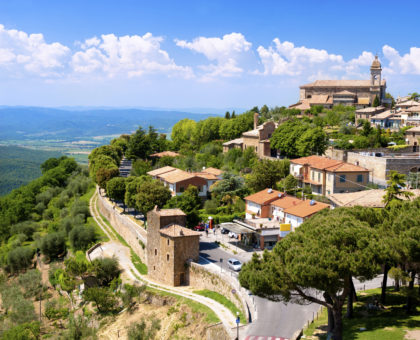
Montalcino e la Val d’Orcia
Pour le rendre célèbre le Brunello, l’un des meilleurs vins rouges du monde. Mais Montalcino est aussi une magnifique ville d’art, qui domine du haut de sa colline les 3000 hectares de vignobles (1500 h dont à Brunello) qui ont donné la gloire et la richesse.
À cheval entre les bassins de l’Ombrone et de l’Orcia, le centre est surveillé par la Forteresse construite en 1361 pour sceller l’entrée de Montalcino dans les possessions de Sienne. Avec la Forteresse, Montalcino symbolise la tour étroite de l’Hôtel de Ville, érigée entre le Deux et le Trois Cent. À ses pieds il y a la Piazza del Popolo et la Loge gothique.
Dans le centre historique il faut faire une visite aussi aux églises de Sant ‘Agostino et de Sant ’Egidio (XIV siècle) et le Musée Civique et Diocésain qui conserve des peintures et des sculptures du 300 au 900 et des terre cuites rouges.
Des rues tortueuses entre les vignobles portent à Torrenieri, Sant ’Angelo in Colle et Poggio alle Mura. À partir de Castelnuovo dell’Abate on rejoint l’abbaye de Sant’Antimo, l’un des chef-d ’œuvres du romanesque en Italie.
Authentiques trésors de la nature et des paysages, la Val d’Orcia accueille certains centres historiques plus intéressants de Sienne et de l’entière Toscane. À partir des rues, aux places, aux églises, le regard ouvre vers le grand horizon des collines.
Des châteaux, des villages, des tours et des monastères isolés complètent l’image d’une fascinante. Même l’art du Val d’Orcia, comme ses parfums et ses saveurs, l’économie et le développement, est fortement liée aux activités agricoles. C’est un exemple significatif le Théâtre Povero di Monticchiello.

Gubbio
Gubbio was important Umbrian town (which was mentioned in the records of the Tables of Gubbio, or Iguvine tables). Allied with the Romans since the early 3rd century. B.C., at the end of the social war they declared it a municipality (Iguvium; later Eugubium). Destroyed by Totila (552) during the war greek-Byzantine war, in the Middle Ages it became a densely populated and flourishing municipality; despite the internal struggles and its participation in the wars between the Papacy and the Empire, it extended its jurisdiction over a vast territory.
One of the many traditional events worth mentioning is the characteristic ‘Corsa dei Ceri’, which takes place each year on 15 May, the eve of the feast of St. Ubaldo, the city’s patron saint.
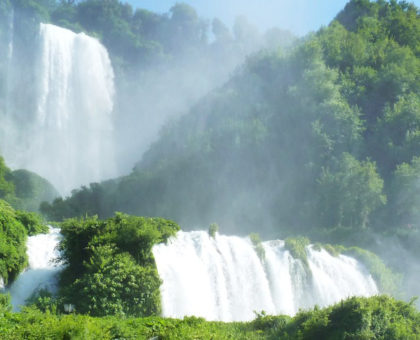
Cascata delle Marmore
The Cascata della Marmore (Marmore Falls), whose beauty has been extolled throughout the centuries, appears as a roaring column of water divided into three sections.
Enshrouding the flora in a cloud of white foam, it covers a vertical drop of 165 meters.
The visitor is regaled with a scenario that is the result of over two thousand years of work by man who has, since Roman times, attempted to channel the waters of the river Velino to make them fall into the Nera river below.
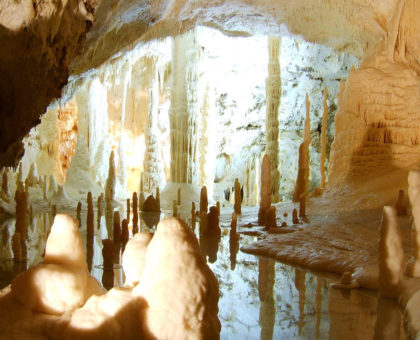
Grotte di Frasassi
The Grotte di Frasassi (Frasassi caves), discovered in 1971 by a group of CAI speleologists, are underground caves located in the municipality of Genga, in the province of Ancona. The cave complex is set within the Regional Natural Park of Gola della Rossa and Frasassi. The complex is formed by a series of caves, the Ancona Abyss is the first and may visited through the current entrance: it measures 180 m x 120 m and has a height of 200 m; is it so large (more than 2 million sqm) that the Duomo of Milan could easily fit within it. Since 1972 it is protected by the Frasassi Consortium, consisting of the town of Gengae of the Province of Ancona, whose objective is to safeguard and enhance its scientific and touristic attractiveness. Since September 1974, part of the caves are open to the public, in time becoming one of the major tourist attractions of the Marches; it is estimated that since then more than 12 million people have visited them.



